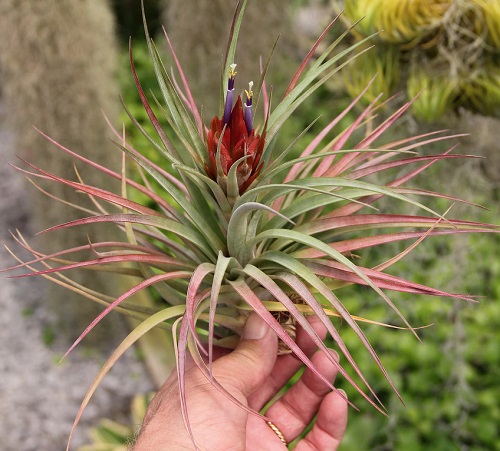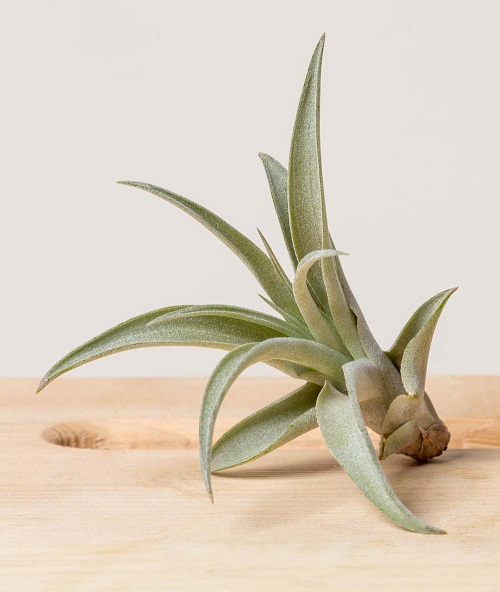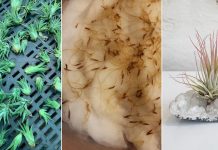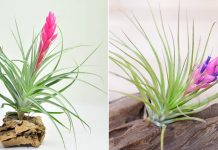Delve into Velutina Air Plant Care to cultivate vibrant, thriving greenery with ease and elegance. Let’s explore how to take care of them.
Velutina Air Plant is a captivating species of epiphytic plants that thrive without soil, making them a unique and low-maintenance addition to any indoor or outdoor space. Let’s delve into the art of nurturing these exquisite botanical wonders, sharing essential tips and insights to help you unlock your full potential and create a lush, vibrant environment that will capture attention and admiration.
Check Out How to Attach Air Plants to Wood here
Velutina Air Plant Information
Velutina Air Plants, scientifically known as Tillandsia velutina, are small epiphytic plants native to Mexico and Central America. They have slender, velvety-textured gray-green leaves and grow to a modest height of 4 to 6 inches. These air plants produce pink or lavender tubular flowers from their rosette-shaped foliage. Velutina Air Plants are low-maintenance, thriving without soil by attaching themselves to surfaces and absorbing nutrients from the air.
They require bright, indirect light and regular misting to stay hydrated but should be protected from freezing temperatures. Overall, they make for a unique and easy-to-care-for addition to any plant collection.
Botanical Name: Tillandsia Velutina
Velutina Air Plant Propagation
Propagating Velutina Air Plants can be done through various methods, including offsets (pups), seeds, and division. The most common and straightforward method is through offsets. Here’s a step-by-step guide on how to propagate them through offsets:
- Wait until your Velutina air plant produces healthy offsets or “pups.” They should be at least one-third to one-half the size of the mother plant before attempting propagation.
- Gently grasp the pup near its base and wiggle it back and forth until it separates from the mother plant. Be careful not to damage the pup or the mother plant during this process.
- After separating the pups, place them in a dry and well-ventilated area for several hours to allow the cut ends to dry and callus. This helps prevent rot when they are attached to a new surface.
- Select a suitable surface for attaching the pups. This can be a piece of driftwood, a decorative rock, a shell, or any other creative surface that allows the pups to be displayed. Ensure the chosen surface is clean and dry.
- Use a small amount of non-toxic adhesive (e.g., waterproof glue or aquarium silicone) to secure the dried end of the pup to the chosen surface. Alternatively, you can use a wire or fishing line to tie the pup to the surface until it establishes itself.
- Place the newly attached pups in a location with bright, indirect light. Maintain the appropriate humidity level by misting them regularly or soaking them in water for about 30 minutes every 1-2 weeks. Ensure that excess water is shaken off after soaking to prevent rot.
- Over time, the pups will grow and establish themselves on the new surface. They will eventually mature into adult plants and may even produce offsets, continuing the propagation cycle.
Explore Harrisii Air Plant Care Guide here
How to Display Velutina Air Plant

1. Hanging Planters
Place Velutina air plants in decorative hanging planters or glass terrariums. These can be hung from the ceiling, mounted on walls, or arranged in clusters for an eye-catching aerial garden.
2. Driftwood and Branches
Attach Velutina air plants to pieces of driftwood or branches using glue or wire. These natural elements provide an organic and rustic display, perfect for a coastal or bohemian-inspired decor.
3. Seashells
Nestle air plants in seashells or small decorative containers for a beachy or coastal-themed display. These small, portable arrangements can be placed on shelves or tables.
4. Geometric Holders
Display air plants in geometric holders made of metal or glass. These modern and minimalist containers provide a contemporary touch to your space.
5. Tillandsia Wreaths
Create living wreaths by attaching Velutina air plants to a wire or grapevine wreath frame. Hang them on your front door or use them as wall decor.
6. Magnetic Pots
Place air plants in small, magnetic pots or holders and stick them to metal surfaces such as refrigerators or filing cabinets for a playful and unexpected display.
7. Shadow Boxes
Arrange air plants in shadow boxes or frames with compartments. This allows you to showcase them while protecting them from direct handling.
8. Glass Orbs
Suspend Velutina air plants in clear glass orbs or globes filled with sand, stones, or other decorative elements. These hanging displays add an ethereal and enchanting touch.
9. Plant Stands
Use small plant stands or holders to elevate Velutina air plants, allowing them to stand out in your indoor garden.
Check Out the Butzii Air Plant Growing Guide here
Feeding Velutina Air Plant
Fertilizing Velutina Air Plant involves using a diluted, water-soluble air plant or bromeliad fertilizer, typically at 1/4 to 1/2 strength, applied monthly during the growing season. You can soak the plants in the diluted fertilizer solution for about 20-30 minutes. Check mist them thoroughly, ensuring full leaf coverage. Rinse the plants afterward to prevent fertilizer buildup, and allow them to dry completely. Also, monitor their response to avoid over-fertilization, ensuring healthy growth and thriving air plants.
Velutina Air Plant Care
Position
Velutina air plant thrives in bright, indirect light. They should be placed near a window with filtered sunlight or in a location with plenty of natural but indirect light. Avoid exposing them to harsh, direct sunlight for extended periods, which can lead to sunburn and damage to their leaves.
Airflow
Adequate airflow is crucial for the health of air plants. Velutina Air Plant, like other Tillandsia species, should be kept in a well-ventilated area. Good air circulation helps prevent moisture from accumulating on their leaves, reducing the risk of rot. Proper airflow is especially important after misting or soaking the plants, as they should dry quickly to avoid fungal or bacterial issues.
Water
Velutina Air Plant requires regular but gentle watering. Mist them thoroughly with water or soak them in a container of water for about 20-30 minutes every 1-2 weeks, depending on the humidity levels in your environment. Remove excess water from the leaves after watering to prevent rot. It’s important not to let water pool in the center of the plant, as this can also lead to rot. In drier climates, more frequent misting may be necessary.
Temperature
These plants thrive in temperatures between 10°C and 32°C. They are sensitive to cold temperatures and should be protected from frost or extreme cold. Avoid placing them near drafty windows or in areas with rapid temperature fluctuations. Additionally, they can tolerate higher temperatures as long as they have proper humidity and airflow.
Pests and Diseases
While Velutina Air Plant is relatively hardy, it can occasionally attacked by pests like spider mites and mealybugs. Regularly inspect your plants for any signs of infestation, such as webbing or cottony masses, and treat them promptly with insecticidal soap or neem oil. To prevent diseases like rot, ensure they dry thoroughly after watering, maintain good airflow, and avoid overwatering. Proper care and vigilance are key to keeping these plants healthy and free from common issues.
Frequently Asked Questions
Q. What are Velutina air plants, and how are they different from regular plants?
Velutina air plants attach themselves to surfaces like trees, rocks, or decorative objects and derive nutrients and moisture from the air. Unlike traditional potted plants, they are known for their distinctive appearance and minimal care requirements.
Q. How do I care for the Velutina air plant?
Velutina air plant thrives in bright, indirect light and requires regular misting or soaking every 1-2 weeks to maintain proper humidity levels. Ensure good airflow to prevent rot and protect them from extreme temperatures, especially frost. Occasional fertilization and prompt pest control may also be necessary.
Q. Do I need to fertilize my Velutina air plants?
Yes, periodic fertilization can benefit Velutina air plants. Use a diluted, water-soluble air plant or bromeliad fertilizer at 1/4 to 1/2 strength once a month during the growing season. Rinse the plants after fertilizing to prevent fertilizer buildup.
Q. What should I do if my Velutina air plant looks unhealthy?
Assess the plant’s care conditions, including lighting, watering, and humidity. Adjust as needed. Trim any dead or damaged leaves and monitor their progress. Proper care can often revive ailing air plants. If problems persist, seek guidance from experienced growers or nurseries.






